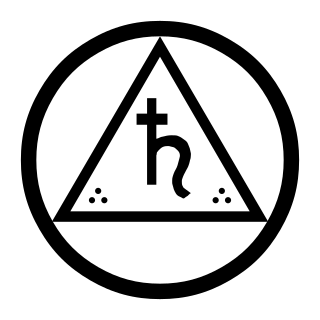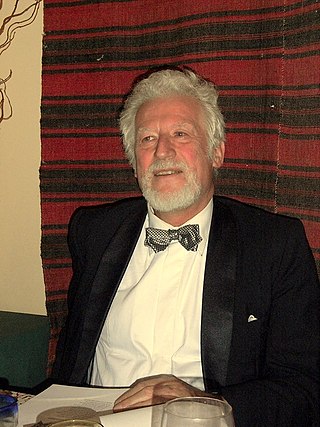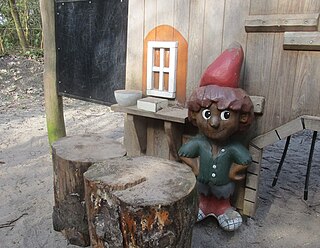The Skoptsy were a cult within the larger Spiritual Christianity movement in the Russian Empire. They were best known for practising emasculation of men, the mastectomy and female genital mutilation of women in accordance with their teachings against sexual lust. The descriptive term "Skoptsy" was coined by the Russian Orthodox Church.

Fraternitas Saturni is a German magical order, founded in 1926 by Eugen Grosche a.k.a. Gregor A. Gregorius and four others. It is one of the oldest continuously running magical groups in Germany. The lodge is, as Gregorius states, "concerned with the study of esotericism, mysticism, and magic in the cosmic sense". The FS adopts a system of degrees, ending with the 33rd as highest degree to reach this goal. The lodge claims further no political or economical objectives. It propagates ideals of freedom, tolerance and fraternity.
Harald Haarmann is a German linguist and cultural scientist who lives and works in Finland. Haarmann studied general linguistics, various philological disciplines and prehistory at the universities of Hamburg, Bonn, Coimbra and Bangor. He obtained his PhD in Bonn (1970) and his habilitation in Trier (1979). He taught and conducted research at a number of German and Japanese universities. He is Vice-President of the Institute of Archaeomythology and director of its European branch.

Peter Rühmkorf was a German writer who significantly influenced German post-war literature.

Johann August Starck also Stark was a prolific author and controversial Königsberg theologian, as well as a widely read political writer now best remembered for arguing that an Illuminati-led conspiracy brought about the French Revolution. Immanuel Kant and Johann Georg Hamann were among his acquaintances in Königsberg. His broadly deistic approach emphasized natural religion and smoothed over doctrinal differences among the various faiths.
The Order of the Golden and Rosy Cross, was a German Rosicrucian organization founded in the 1750s by Freemason and alchemist Hermann Fictuld. Candidates were expected to be Master Masons in good standing. Alchemy was to be a central study for members. Much of the hierarchical structure for this order was used in Societas Rosicruciana in Anglia (SRIA) and from there, the Hermetic Order of the Golden Dawn.

The Jungfernhof concentration camp was an improvised concentration camp in Latvia, at the Mazjumprava Manor, near the Šķirotava Railway Station about three or four kilometers from Riga. The camp was in operation from December 1941 through March 1942, and served as overflow housing for Jews from Germany and Austria, who had originally been intended for Minsk as a destination.

Medingen Abbey or Medingen Convent is a former Cistercian nunnery. Today it is a residence for women of the Protestant Lutheran faith near the Lower Saxon town of Bad Bevensen and is supervised by the Monastic Chamber of Hanover. The current director of the abbey (Äbtissin) is the art historian Dr Kristin Püttmann.

Adonism is a Neopagan religion founded in Austria in 1926 by the German esotericist Franz Sättler, who often went by the pseudonym of Dr. Musalam. Although Sättler claimed that it was the continuation of an ancient pagan religion, it has been recognised by academics as being "instead the single-handed creation of a highly gifted and educated man", this figure being Sättler himself. Adonism is a polytheistic religion, revolving around a belief that there are five principal gods: Belus, Biltis, Adonis, Dido and Molchos. Adonis is the most prominent of these in the group's theology, being a benevolent figure that Sättler equated with the Christian figure of Satan. In contrast to Adonis, Molchos is believed by Adonists to be malevolent, and to be responsible for the enslavement of humanity through monotheistic religions such as Judaism, Christianity and Islam: the religion therefore has "a pronounced anti-Christian bias".

Bodfeld was a small royal palace or lodge that was primarily established for hunting purposes and, when the town of Elbingerode emerged, for the administration of ore mining in the central Harz that underpinned the power of the Ottonian and Salian kings and emperors in medieval Europe. The term Bodfeld is also used to describe an area of forest that lies predominantly south of Elbingerode.

Walter Höllerer was a German writer, literary critic, and literature academic. He was professor of literary studies at Technische Universität Darmstadt from 1959 to 1988. Höllerer was a member of the Group 47, founder of the German literary magazine Akzente (1953) and the Literary Colloquium of Berlin (1963).

The Reifenstein schools were the various schools of higher education for women associated with the Reifensteiner Verband.

Agathe Lasch was a German philologist. She was the first female professor of German studies in Germany, and the first female professor at the University of Hamburg. She is a pioneer of the historical study of the Middle Low German language. As a Jew, Lasch was murdered during the Holocaust.
Wilhelm Martin Luther was a German librarian, musicologist and director of the Göttingen State and University Library.

Alexander Moutchnik is a professor of media economics and media management. He focuses on social media, media history, sustainability and corporate social responsibility. Since 2013 Moutchnik has been teaching at the RheinMain University of Applied Sciences in Wiesbaden (Germany) in the Department of Design, Computer Science and Media.
Hubert Kaufhold is a German legal scholar and judge, with special research interests in the languages and legal history of the Christian Orient.

The album amicorum was an early form of the poetry book, the autograph book and the modern friendship book. It emerged during the Reformation period, during which it was popular to collect autographs from noted reformers. In the 1700s, the trend of the friendship book was still mainly limited to the Protestant people, as opposed to the Catholics. These books were particularly popular with university students into the early decades of the 19th century. Noteworthy are the pre-printed pages of a friendship book from 1770 onwards, published as a loose-leaf collection by the bookbinder and pressman Johannes Carl Wiederhold (1743-1826) from Göttingen.

Helmut Birkhan is an Austrian philologist who is Professor Emeritus of Old High German Language and Literature and the former Managing Director of the Institute for Germanic Studies at the University of Vienna.

Wolfgang Golther was a German philologist who specialized in Germanic studies. A professor at the University of Rostock, Golther was a prominent authority on Medieval German literature and Germanic religion.

The Nis Puk (sometimes also Niß Puk (German:[ˈnɪspʊk]), in Danish also Nis Pug(e)) is a legendary creature, a kind of Kobold, from Danish-, Low German- and North Frisian-speaking areas of Northern Germany and Southern Denmark, among them Schleswig, today divided into the German Southern Schleswig and Danish Northern Schleswig. An earlier saying says Nissen does not want to go over the Eideren, i.e. not to Holstein to the South of Schleswig. Depending on the place, it can either appear as a domestic spirit or take on the role of a being generally called Drak or Kobold in Danish and German mythology, an infernal spirit making its owner wealthy by bringing them stolen goods.
















